Machine learning (ML) technologies have become essential in various industries, including healthcare, human resources, and finance. They are used in applications such as computer vision, large language models (LLMs), speech recognition, and self-driving cars. However, there are complications associated with ML. The datasets used to train ML models are often aggregated by humans, who are susceptible to bias and prone to error. Even if an ML model itself is unbiased and accurate, using it in the wrong context can lead to unintended harmful consequences. Therefore, diversifying the usage of enterprise AI and ML is crucial for maintaining a competitive edge.
There are five major types of ML algorithms, each with unique benefits and capabilities. These types are supervised learning, unsupervised learning, semi-supervised learning, self-supervised learning, and reinforcement learning.
Supervised learning involves training a model on a labeled dataset, where the outcome variable is known. It is commonly used for risk assessment, image recognition, predictive analytics, and fraud detection. There are several algorithms used in supervised learning, including regression algorithms, classification algorithms, naïve Bayes classifiers, neural networks, and random forest algorithms.
Unsupervised learning algorithms, such as Apriori, Gaussian Mixture Models (GMMs), and principal component analysis (PCA), draw inferences from unlabeled datasets. They enable exploratory data analysis, pattern recognition, and predictive modeling. Cluster analysis and association algorithms are commonly used in unsupervised learning.
Self-supervised learning (SSL) allows models to train themselves on unlabeled data, eliminating the need for massive annotated datasets. SSL algorithms learn one part of the input from another part, automatically generating labels and transforming unsupervised problems into supervised ones. SSL is particularly useful in computer vision and natural language processing (NLP) tasks.
Reinforcement learning involves training algorithms using a system of reward and punishment. An agent takes actions in an environment to reach a goal and is rewarded or penalized based on its actions. Reinforcement learning algorithms are commonly used in video game development and teaching robots how to perform human tasks.
Semi-supervised learning combines elements of supervised and unsupervised learning. These algorithms are trained on a small labeled dataset and a large unlabeled dataset, with the labeled data guiding the learning process for the unlabeled data. Generative adversarial networks (GANs) are an example of semi-supervised machine learning.
Regardless of the type, ML models can provide valuable insights from enterprise data. However, their susceptibility to bias and errors necessitates responsible AI practices. IBM watsonx.ai AI studio offers developers a platform to manage ML algorithms and processes effectively. It combines generative AI capabilities with an enterprise studio to train, validate, tune, and deploy AI models efficiently.
As the adoption of ML technology continues to accelerate, understanding AI and ML technologies becomes increasingly important. The global machine learning market is expected to reach USD 188 billion by 2030. With the proliferation of data, AI and ML are integral to both day-to-day business operations and technological innovation. They present an opportunity to diversify enterprise IT infrastructures and create technologies that benefit businesses and the people who depend on them. Explore the watsonx.ai AI studio to harness the power of ML and AI for optimal performance.
Source link






















